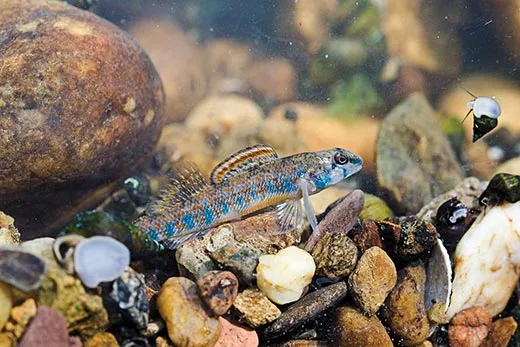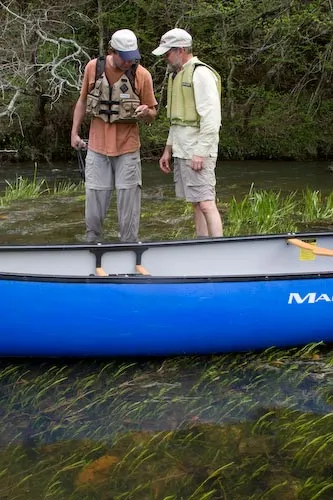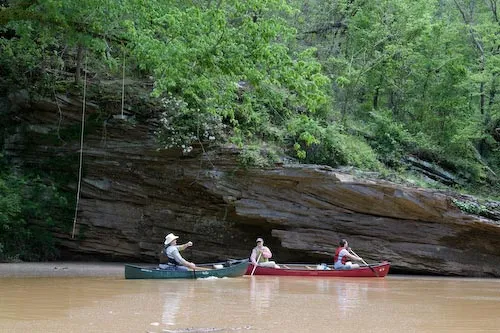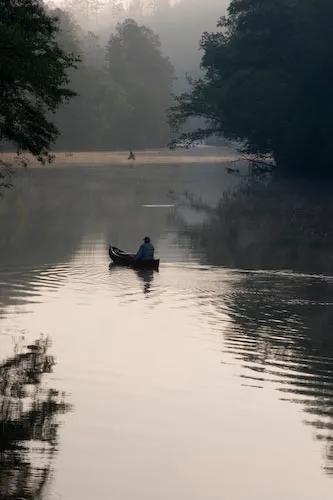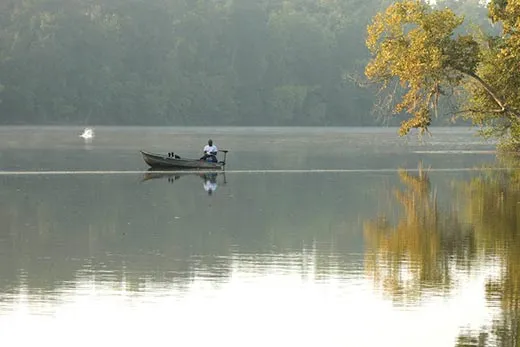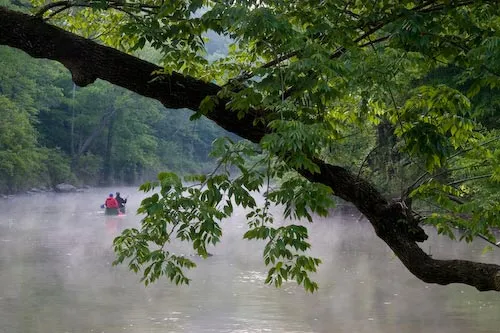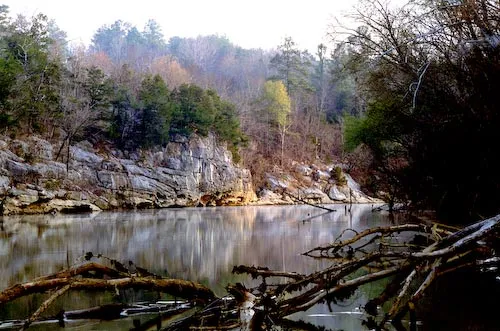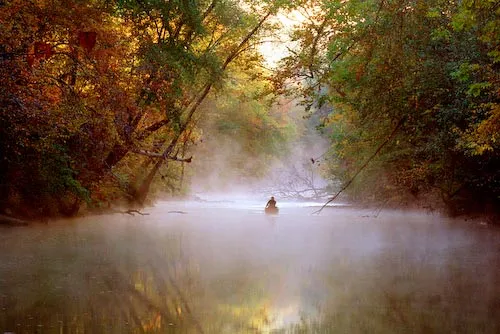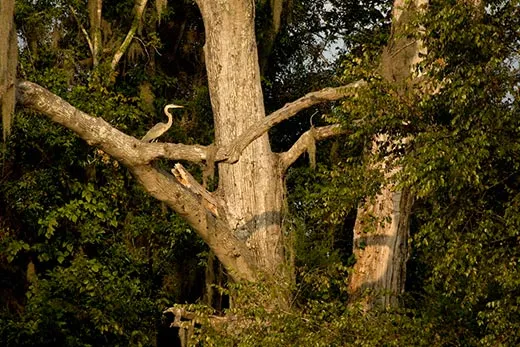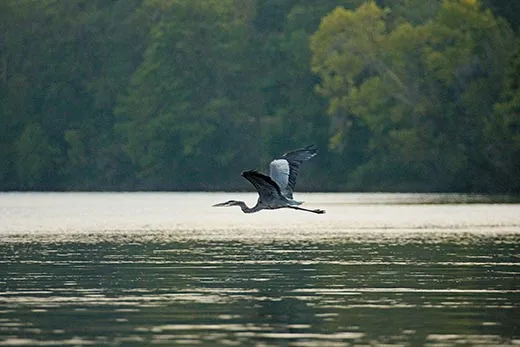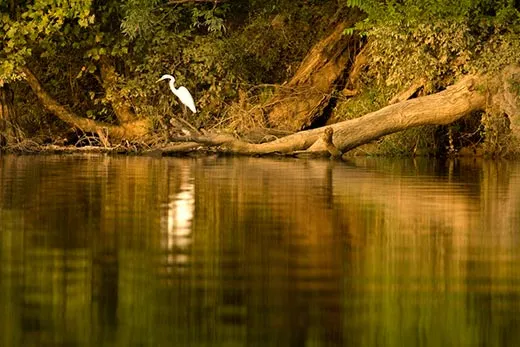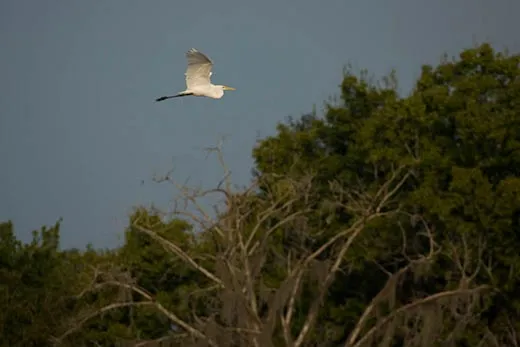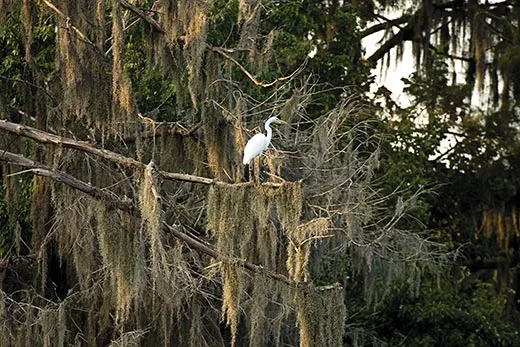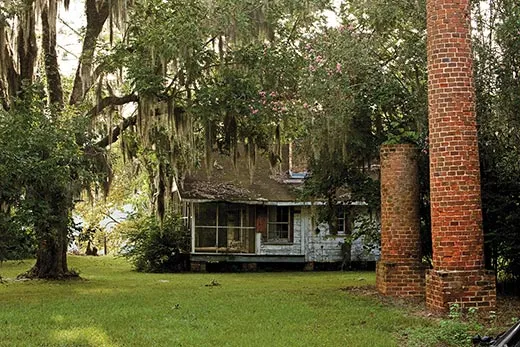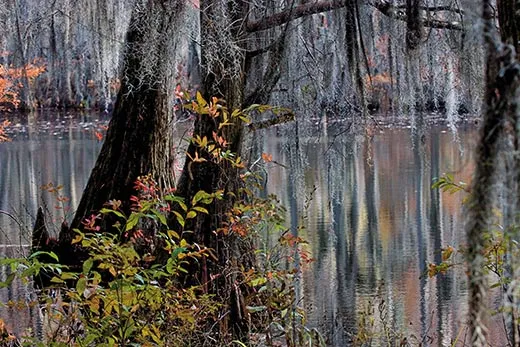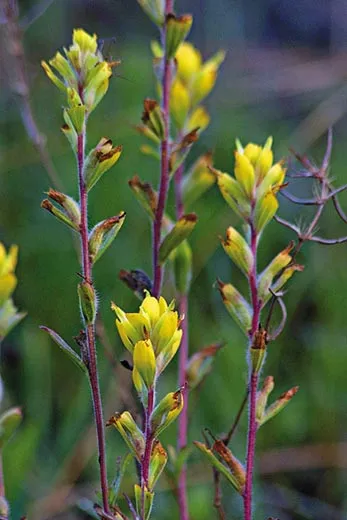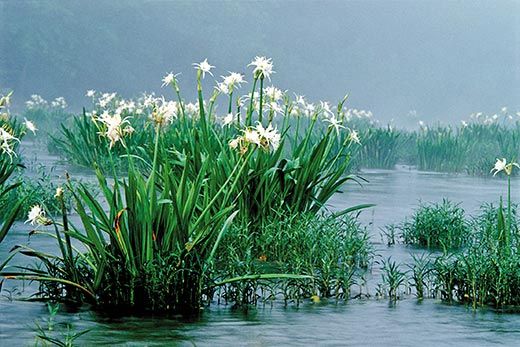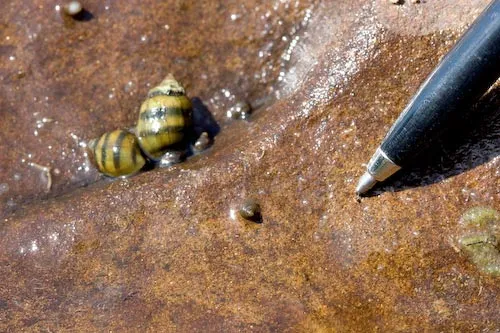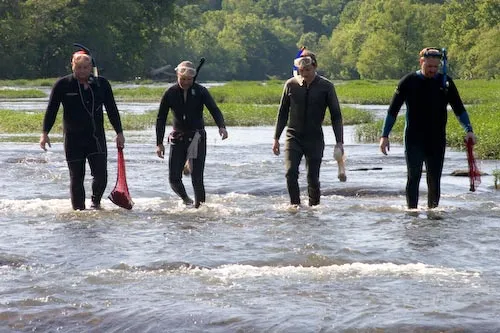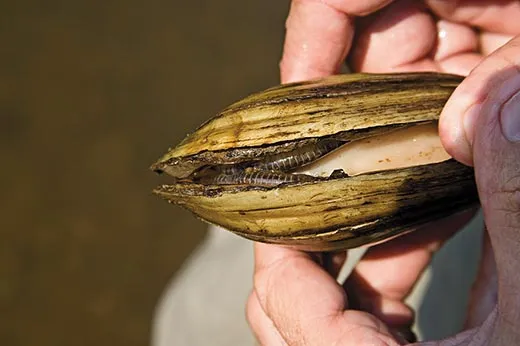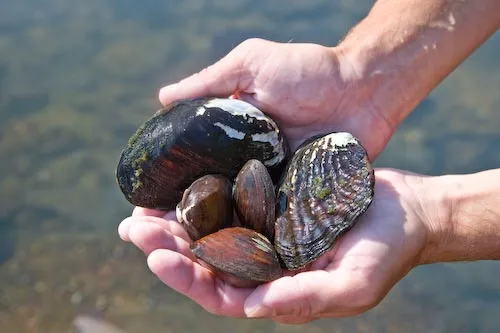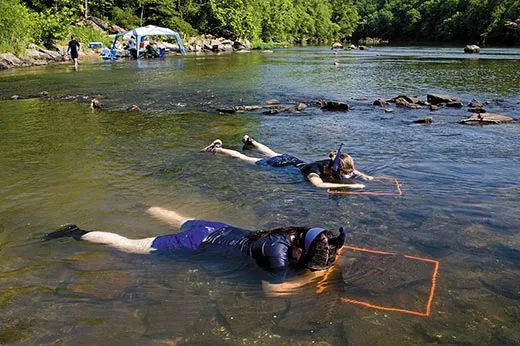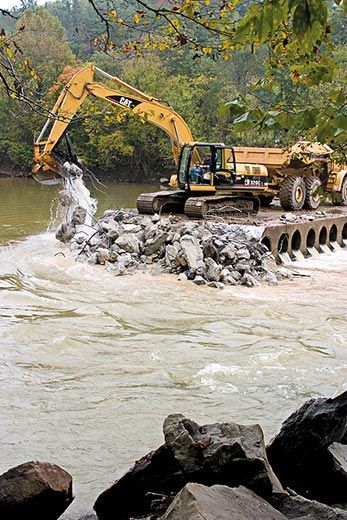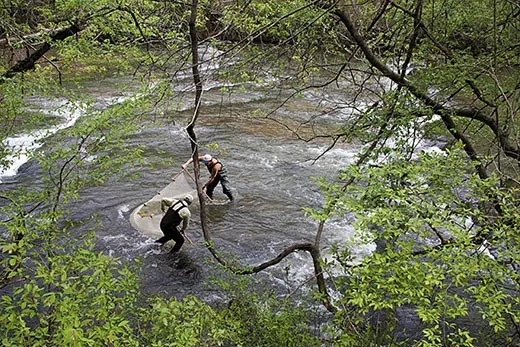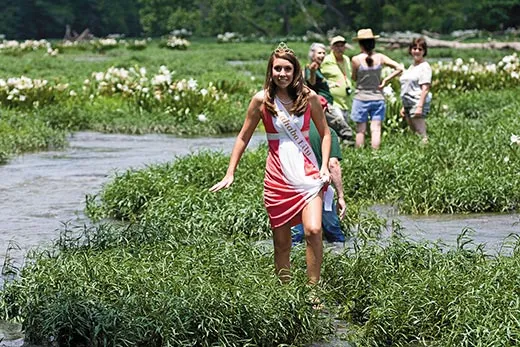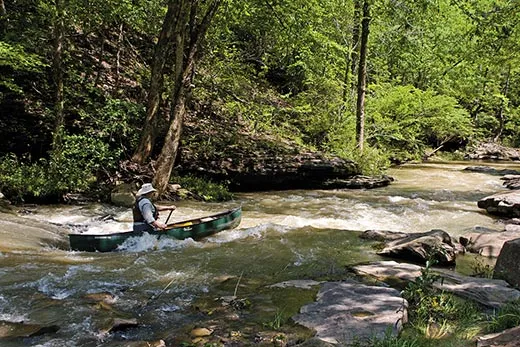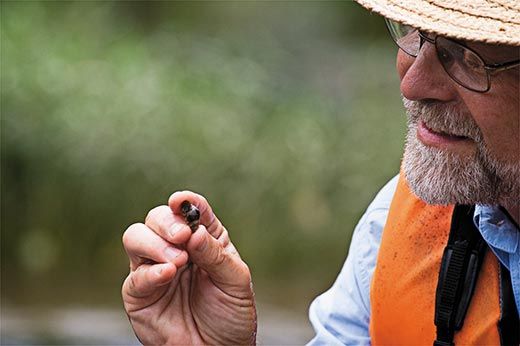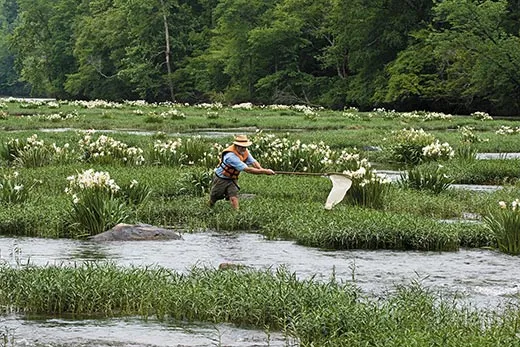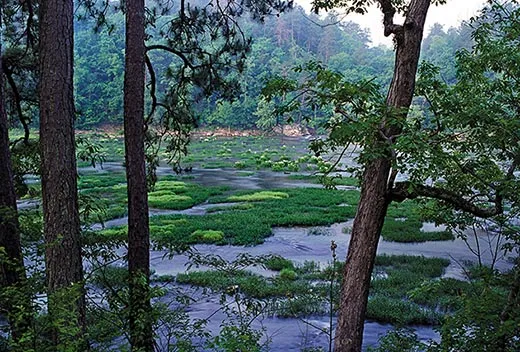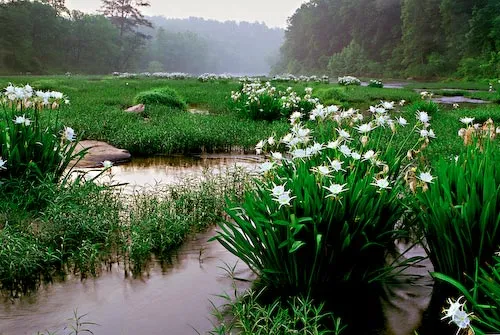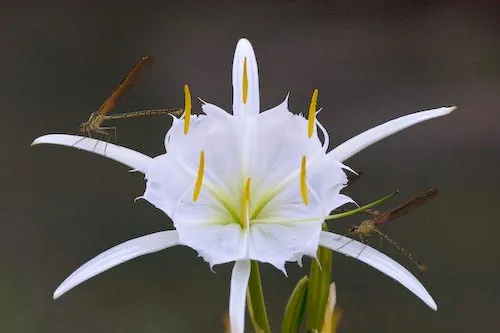The Cahaba: A River of Riches
An unsung Alabama waterway is one of the most biologically diverse places in the nation, home to rare flora and fauna
/https://tf-cmsv2-smithsonianmag-media.s3.amazonaws.com/filer/Cahaba-River-Halfmile-Shoals-631.jpg)
Randy Haddock stands on a muddy riverbank in central Alabama, looking over his favorite place on earth. Haddock, a slight, spectacled biologist with a trim beard, smiles as he hoists a canoe over his head, carries it to the water and launches it almost soundlessly into a calm stretch of the Cahaba River.
Between brilliant-green margins of broad-leaved trees, the Cahaba flows from its headwaters near Springville through the suburbs of Birmingham and into the heart of the state. The river slips southward with barely a murmur, unnoticed by many who live nearby. But Haddock, who has plied it for 20 years, knows the Cahaba as one of the grandest places in North America.
Biological splendor is usually associated with faraway places and fabulous creatures, rain forest river basins or African elephants. The close-to-home grandeur of the Cahaba is more subtle, counted not in jaguars or monkeys but in snails and mussels. To those willing to look closely, though, the river is as fascinating as any jungle.
The Cahaba boasts the longest free-flowing stretch of river in Alabama—140 miles—and one of the longest in the Southeast. Biologists have found that it shelters more fish species per mile than any other river in the country. Its floral attractions range from a spectacularly showy lily to a low, unassuming prairie clover, one of several local plant species that, until recently, were entirely unknown to science.
"I keep seeing things I've never seen before, so I feel compelled to keep learning," says Haddock, as he dips his paddle in the water and sets off downstream. "The Cahaba is different every time."
This overcast spring morning, our quarry is big botanical game. The river stretches ahead of our canoes in a long, silent pool, a promising sign for our small group of lily hunters. "The bigger the pool, the bigger the shoal," Haddock says. Shoals—rocky bars that reach across the river—trap lily seeds as they tumble downstream and shelter them as they sprout.
The river bends, and Haddock hears water babbling ahead. Moments later, the lilies loom into view, their bushel-size bunches arrayed in rows, their papery, moon-faced flowers forming a frothy fence. Our group falls quiet. Some of us are seeing the lilies for the first time, some for the hundredth, but the sudden expanse of blooms silences even the veterans.
As our canoes float into the rocky shoal, the lilies seem to engulf us, the giant pale flowers reaching to our chins. Though the Cahaba lily, also known as the shoals spiderlily, once grew throughout the Southeast, it's now restricted to about 70 stands. A quarter of the stands are in the Cahaba River, and one of the densest and largest is found here. Their display is as fleeting as it is rare. The lilies begin to bloom on the Cahaba in May, with each flower opening in the evening and lasting but a single day. The entire spectacle is over by mid-June.
Botanists have praised the flower's beauty for centuries: "nothing in vegetable nature was more pleasing," wrote itinerant naturalist William Bartram, who explored the Southeast just before and during the American Revolution. But few had studied the flowers, and questions remained about their basic biology.
Haddock, trained as an ecologist, moved to Birmingham in 1988 for a medical-research job at the University of Alabama and volunteered to lead canoe tours for the Cahaba River Society in his spare time. Though no one knew exactly why the flowers opened at night, Haddock suspected a nocturnal pollinator and decided to test his hunch.
One May evening, Haddock paddled out to a shoal and settled in among the lilies. He waited through one night and into the next, until finally he saw something flitting from flower to flower. Luckily, the pollinator then flew close enough to Haddock for him to identify it as a sphinx moth—solving one of the Cahaba River's many long-standing mysteries.
Haddock is still plumbing the Cahaba's secrets. He pauses near an especially dense stand of lilies, clambers out of his canoe and picks his way over the rocks until he finds a Cahaba pebblesnail, no larger than a ball bearing.
Until a few years ago, this snail was thought to be extinct, just one more species lost to the wave of extinctions on Southeastern rivers. Plant and animal species took refuge in the region during the last ice age, when glaciers covered the north, then thrived and diversified for millennia in the region's wet, warm climate. But as rivers were dammed for hydropower and transportation over the past century, species began to blink out.
The region's lush rivers—which the eminent biologist and Alabama native E. O. Wilson calls an "aquatic treasure house"—continue to lose species. Alabama now leads the lower 48 in extinctions, due mostly to disappearances among its freshwater fauna: the Coosa River, which runs alongside the Cahaba a few dozen miles to the east, lost 34 species of snails—half its entire inventory—in the 50 years between 1914 and 1964. This is considered by many experts to be the largest recent extinction event of any kind in the United States.
The Cahaba, too, has suffered casualties. Because of water pollution and other stresses such as sediment from erosion, almost a quarter of its original complement of mussel species has disappeared, and snails and fish are thought to have experienced similar declines. But the Cahaba, only 190 miles long, has also held on to a remarkable number of its native plants and animals—including 13 species of snails found nowhere else in the world, among them the humble Cahaba pebblesnail. In 2004, a visiting Australian biologist discovered that the snail thought to be extinct was simply hiding on the underside of rocks, where no one had bothered to look.
Several years ago, a Georgia botanist named Jim Allison identified eight previously unknown flower species along the river, an almost unheard-of haul in contemporary North America. The plants grow on a rare type of magnesium-rich rocky soil. Further investigation turned up eight more species never before found in the state, including one not seen anywhere since the 1830s. The Cahaba River's allies feel certain that more biological treasures lie in the glades, oxbows and shoals—all just waiting for someone to study them.
Such discoveries—and rediscoveries—are worth celebrating, say Haddock and other biologists. Snails and mollusks may not inspire us like bald eagles or blue whales or, for that matter, the flashy Cahaba lily. But they form the bedrock of healthy ecosystems, maintaining water quality by eating algae, feeding ducks, fish, crayfish and turtles, and, through their sensitivity to pollution, serving as early indicators of environmental trouble. "For these river systems in the Southeast, they are the keystone species," says Paul Johnson, program supervisor of the Alabama Aquatic Biodiversity Center.
When local game warden Ricky LeCroix buzzes up to the shoal in his airboat to say hello, Haddock is holding a tiny endangered snail called a cylindrical lioplax—and is engaged in an earnest lecture on snail sex. Some snails are both male and female, Haddock explains. But since the lioplax has separate sexes, it must work harder to find a mate in order to reproduce.
"Yeah," drawls LeCroix. "And when you only move six inches a year, you sure can't play hard to get."
But the Cahaba is more than a museum of rare Southeastern river species. It also serves as a laboratory for their recovery, thanks to the recent demolition of the Marvel Slab, a road crossing built in the 1960s as a shortcut across the river for coal trucks. Though a row of small culverts allowed water to flow through the structure, it acted like a dam and changed the speed of the current, destroying snail and mussel habitats and blocking fish as they tried to swim upstream to spawning grounds.
"You'd see schools of fish literally banging their snouts on the face of the dam, trying to travel upstream," says Paul Freeman, an aquatic ecologist for the Alabama chapter of the Nature Conservancy. Once a popular angling spot, the area upstream of the Marvel Slab had lost most of its fish population.
Throughout the country, small, outdated dams and other river barriers like the Marvel Slab are coming down. Many are no longer needed for their original purposes and have become safety hazards, environmental disasters or both. Their removal can jump-start river restoration and has yielded prompt and dramatic results in Maine, Florida, Arizona and elsewhere. But in Alabama, no dam had ever been removed for environmental reasons. Freeman and other supporters of the idea spent five years politicking in local communities and collecting the necessary bureaucratic approvals.
In 2004, the federal Army Corps of Engineers—the agency with authority over the Marvel Slab—and a host of other private and public agencies finally got the go-ahead. Biologists in wet suits and waders, armed with nets and plastic buckets, spent three days moving more than 12,000 snails and mussels out of the way, then donned hard hats to watch the removal of the slab. Though "all the guys really wanted to blow up the dam," says Wendy Smith of the World Wildlife Fund, construction experts recommended it be picked apart with a heavy-duty jackhammer. Doing so uncorked the longest free-flowing stretch of river in Alabama.
The results were dramatic. "The fish came back within hours, and the snails came back within days," says Freeman. Each summer since, Freeman and his colleagues have snorkeled at the former slab site, counting snails and mussels. In the past two years, the crew found as many as 2,000 snails per square meter in some places, up from only a handful or none at all before the removal. They have also documented a jump in native mussels. "Life rebounds pretty quickly when you give it a chance," says Freeman.
After discussions with Freeman and other biologists, officials from the Army Corps recently agreed to change the management of the two remaining river barriers between Birmingham and the Gulf of Mexico. This past spring, the Corps began opening and closing the locks on the Alabama River on a schedule designed to allow more native migratory fish to return to the Alabama and Cahaba rivers.
That could help a fish that is one of the rarest vertebrates in North America: the Alabama sturgeon, which resembles a small shark with whiskers and was once found in rivers throughout the area. In the spring of 2007, biologists were thrilled to find a lone sturgeon on the Alabama, the first seen in nearly seven years. They hoped it was a female, which they would be able to breed using stored sturgeon sperm, but it turned out to be a male. The biologists implanted a tag in it and released it back into the Alabama, where it lives today—one of the last of its kind.
Below the Marvel Slab site, the Cahaba continues its course southward toward the Alabama River. Its murmurs grow even quieter and its bends more generous, looping over the coastal plain. Cypress trees, their fluted buttresses punctuated with knobby "knees," line its banks, and the air fairly sags with moisture. Here, old river oxbows become steaming swamps, hung with Spanish moss and home to carnivorous plants and the occasional alligator.
This tropical stretch, far from Birmingham and other cities, is even less traveled than the lily shoals, and even experienced canoeists and anglers can trip up on the unknown. On one of his first dates with his future wife, Shannon, Haddock suggested an exploration of the Oakmulgee, a Cahaba tributary. The stream turned out to be so overgrown and littered with fallen logs that the pair traveled in circles, managing to escape only after a marathon bushwhack. "I couldn't believe she was still speaking to me the next day," Haddock says.
Like the rest of the river, the lower Cahaba burgeons with diversity. Fish dart underneath canoes, and a few handfuls of river mud can contain a foot-long washboard mussel or a tiny, delicately striped fawn's foot mussel. Fish throughout the Southeast have endearingly quirky common names, and those here are no exception. "There's a frecklebelly madtom, a freckled madtom, a speckled madtom, a speckled darter and a freckled darter," Haddock singsongs. "But there's no frecklebelly darter."
The lower Cahaba also winds through history. It passes near the Edmund Pettus Bridge, which crosses the Alabama in Selma and is infamous as the site of a 1965 clash between police officers and unarmed civil rights demonstrators. The Cahaba ends at the remains of Old Cahawba, the state's first permanent capital. During the cotton boom on the surrounding prairies, Cahawbans built fine mansions—including the then-largest in the state—on broad streets named Mulberry, Pine, Oak and Chestnut. Ferries operated on both the Cahaba and Alabama rivers, and in the wet season, even steamboats made their way up to the Cahaba Valley.
But in the 1820s, the state capital moved to Tuscaloosa; after the Civil War, the county seat moved to nearby Selma, and residents followed, many dismantling and moving their elegant houses. The town site became a refuge for freed slaves and, in more modern times, an overgrown patchwork of fishing and hunting camps.
Today, Old Cahawba is a state historical site, a nature reserve and a ghostly place. The chinaberry-lined streets are dotted with ruins, filled with legends of shootouts and panther sightings, and silent but for the chatter of birds and insects. Under a high, wooded riverbank, near the red-brick columns of a former Old Cahawba mansion, the placid Cahaba meets the much larger Alabama, and flows quietly toward the sea.
Michelle Nijhuis has written about aspen trees and Walden Pond for Smithsonian.
Beth Maynor Young's photographs appear in Headwaters: A Journey on Alabama Rivers.
